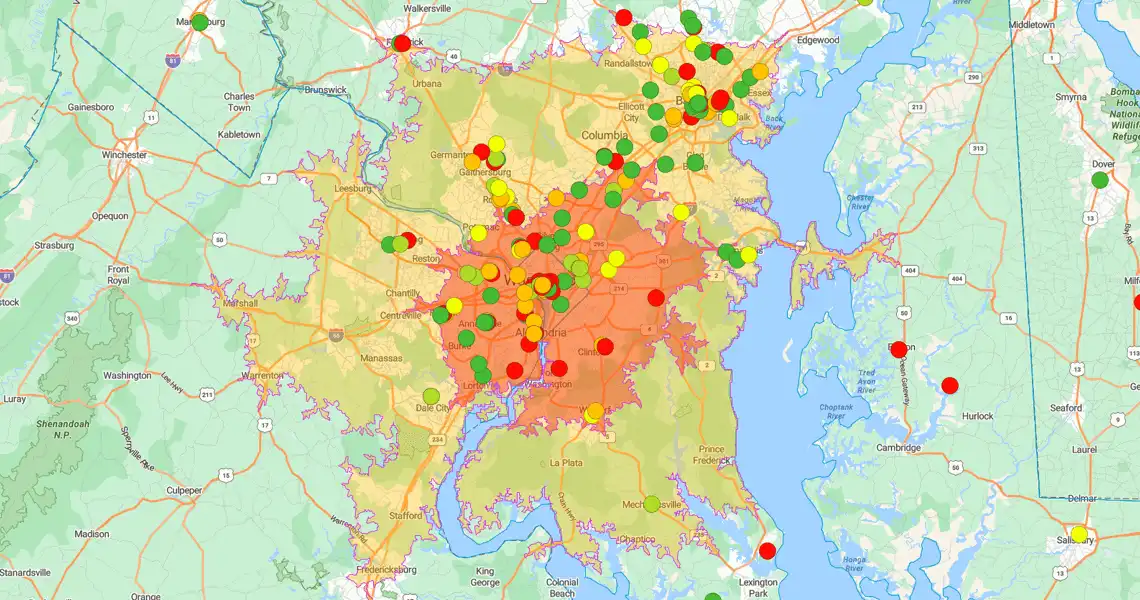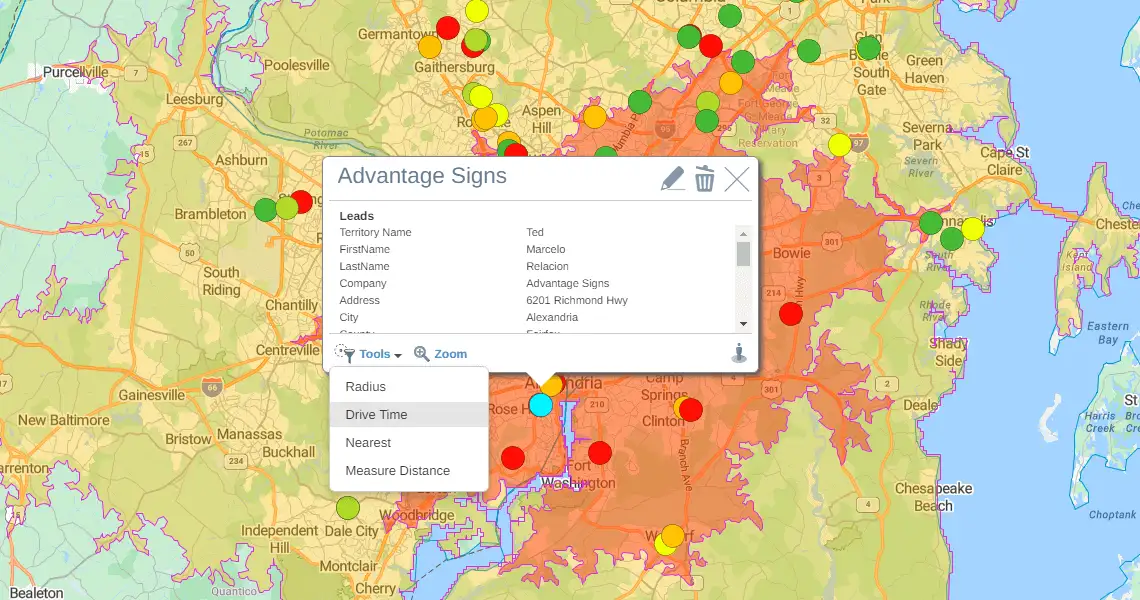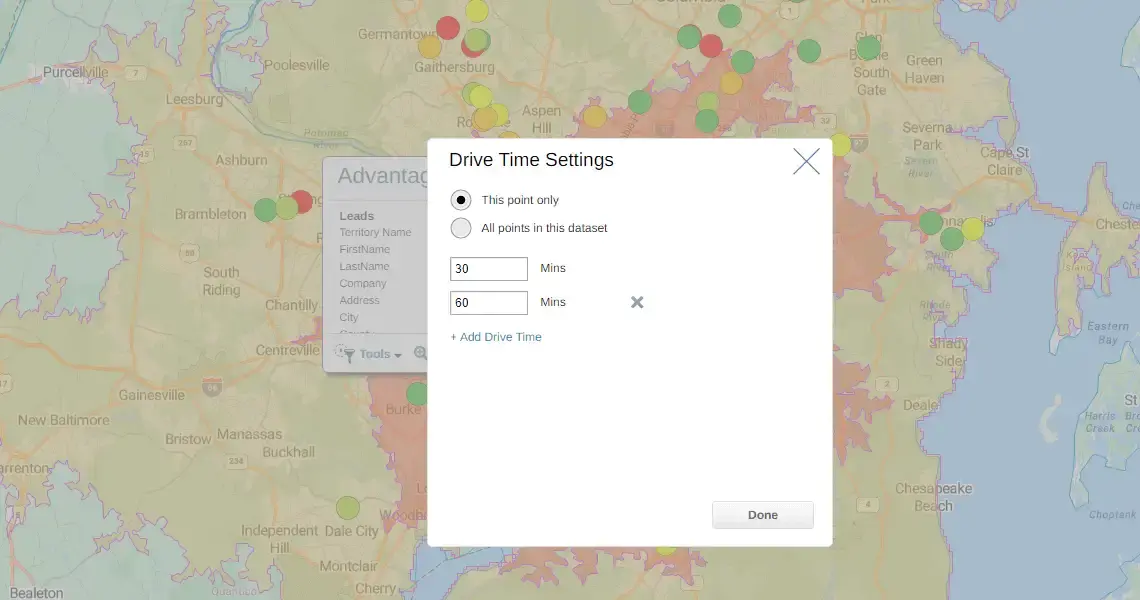Business professionals are always on the move, meeting existing and prospective clients, attending events, delivering products, or engaging in other business operations.
When planning sales-based trips, the first question that will likely spring to mind is, "How soon will I get there, and which route should I use?" Thankfully, drive time analysis software allows you to analyze commute times and other transportation logistics efficiently to execute your business model and satisfy diverse clients' needs.
This guide will look into the definition of drive time analysis, its uses, and the various ways you can leverage the tool to stay ahead of the curve, no matter your industry.
What is Drive Time Analysis?
Drive time analysis is a tool that uses geographic information system (GIS) tools to process spatial data and analyze the time-based distance between two data sets. Besides evaluating speed limits, it provides the routes to take when driving to different locations within a specific area.
Various factors affect drive time calculations. These include speed limits, traffic, road conditions, and physical obstacles like waterways. Typically, drive time analysis tools like eSpatial provide a vivid visual representation of drive time zones on a map. It gives you insight into the accessibility of different locations from a specific point.

30 minute drive time buffer highlighted in red
60 minute drive time buffer highlighted in yellow
So what does all this mean in simple terms? Ultimately, drive time analysis is like using a high-tech map to figure out how long it will take to drive from one place to another by car, considering all the things that could slow down or speed up the route.
Let’s look at an example. You’re planning a promotional event for a new product launch and want to invite potential clients who can reach the venue within an hour's drive. By using drive time analysis, you can pinpoint which areas around the venue fall within a one-hour drive, factoring in typical traffic conditions for the time of the event. This information ensures that your invited guests are more likely to attend because the venue is conveniently accessible to them, boosting brand awareness and attendance at your event.
What is Drive Time Analysis Used For?
Drive time analysis is a valuable tool for businesses in many industries, allowing them to analyze travel times and distances between locations. This is handy when optimizing delivery routes, creating efficient distribution networks, and even reducing transportation costs.
Let's delve deeper into how to use drive time analysis tools to improve your operations and marketing efforts.
1. Identifying Sales Locations
For retailers with multiple locations, a drive time map can help optimize store locations, identify gaps in coverage, pinpoint new locations, and reach more target customers.
Let’s look at an example: Say you run a chain of pharmacies and need to know how many customers are within a 30-minute drive of your store. You’re running this analysis because you currently advertise in local media, reaching customers within 60 minutes of your stores.
Using drive time analysis, you discover that 95% of your customers live within 30 minutes of your existing pharmacy locations. With this insight, you can focus your marketing spend on smaller geographic areas — cutting 40% of your marketing costs.
2. Analyzing Market Reach
With a drive time radius map, you can assess the audience size likely to consume your campaign content from a specific location. The tool usually visually represents how far your target market can travel within a particular time frame from an exact spot.
Suppose customers are willing to drive for about half an hour to access your services. In that case, your request can be, "I want to find the best location for a launch event that ensures our customers' drive time is less than 30 minutes (so I'll plot all potential locations and my customers)."
Your drive time analysis should clue you in on optimal locations for your marketing campaign to maximize accessibility to the largest possible portion of your target audience. With it, you can also:
- Gain a better grasp of your service area
- Select the best sites for promotional events and product launches to boost attendance and participation
- Understand your customers' behavior and their willingness to travel to meet their needs
3. Optimizing Supply Chain Routes
Drive time analysis has proved useful in route optimization. This strategic approach can substantially eliminate bottlenecks within your supply chain, streamlining operations and improving efficiency. This tool gives you access to a map radius by drive time so you know the locations you can reach based on various time constraints. Then, it becomes easy to identify the most efficient and time-effective supply chain routes.
eSpatial works with some of the biggest global logistics organizations. They leverage it to determine map drive time and sell their services to potential customers. For example, a shipping company can input a request such as, "I want to find the best location for a distribution center so I can guarantee customers a 30-minute or less delivery time."
After the drive time analysis, the company can confidently identify routes to minimize transit times and promise customers a 30-minute turnaround. This is despite factors like traffic and road conditions.
4. Assessing Property Values
In the real estate industry, you can use a drive time radius map to analyze property values. If you're a potential investor, consider the accessibility of a home to determine whether sinking your money into it is a smart decision.
In addition, drive time analysis can help you gauge the desirability of a property based on its proximity to amenities. For example, type in, "I want to find all properties within 15 minutes of an office location.” This will give you a list of homes with shorter drive times to your workplace.
5. Reducing Delivery Times
Drive time analyses play a significant role in reducing delivery times to boost customer satisfaction. Apart from optimizing route planning, a map with drive time radius helps you choose the shortest travel times, maximizing the efficiency of the delivery process.
It's worth mentioning that reduced delivery times don't just keep your customers smiling. They also:
- Inspire customer loyalty
- Give you a competitive advantage
- Improve conversion rates
- Enhance business agility
- Build a good reputation
6. Planning Your Schedule
A drive time map radius can allow you to overcome time management challenges. These fundamental tools help you approximate travel time between business appointments. Since they rely on real-time traffic data, they may enable you to steer clear of congested regions, as driving through them may cause delays.
To prepare for unforeseen circumstances, consider buffer time between your daily appointments. It can also combat the stress of missing deadlines or attending client meetings late.
How to Use Drive Time Analysis in eSpatial
Using eSpatial's data time analysis tool is a breeze. Before you begin the process, have a central location in mind. For instance, if you're a business, this could be your office or warehouse. Then, follow these steps:
- Hit the "Drive Time" button in the tool's “Analyze" window
- Use the drop-down feature to specify the “Find” dataset you prefer
- Select the time limit (up to 120 minutes) for driving distance
- Choose your central location from the “From Central Points” dataset
- Decide your dataset table's content, such as drive times, distance columns, and units
- Wait for the tool to add your drive time analysis to your radius drive time map
Afterward, you can edit your drive time analysis however you want. eSpatial also lets you clear or save it at your convenience.
Mapping Solutions for Businesses From eSpatial
Drive time analysis can significantly enhance your business operations. With the tools' location-based services, you can gain valuable insight into your market reach, customer behavior, work ethic, and other factors shaping your brand's trajectory.
To optimize your routing and logistics strategy and achieve a competitive advantage, explore eSpatial's drive time analysis tool. Our radius drive time map offers in-depth market analysis across various geographical regions, proving invaluable for targeted marketing initiatives and strategic business expansion. Moreover, our advanced mapping solutions provide a flexible framework, perfectly aligning with your business goals and adapting to the evolving needs of your clients.
Ready to propel your business forward? Incorporate our cutting-edge territory mapping software into your operations today!
 by
by 


